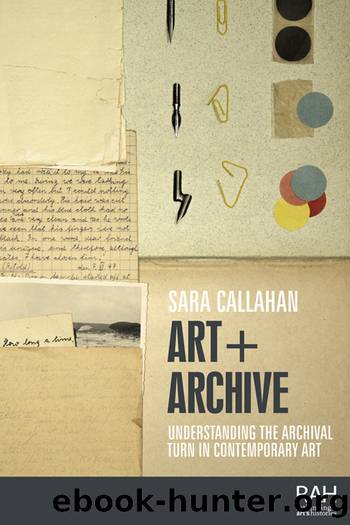Art + Archive by Sara Callahan;

Author:Sara Callahan; [Callahan, Sara]
Language: eng
Format: epub
ISBN: 9781526156846
Publisher: Manchester University Press
Koester's statement about the obfuscations and attempts by the university authorities to hide the troublesome facts about the student shootings at Kent State highlights another key element of the notion of the archive as it is referenced at the turn of the twenty-first century. The archive is at this time increasingly understood as institutionally framed and intimately concerned with power. Not only do various injustices relating to gender, religion and race determine what is and what is not included in an archive, but the interpretative possibilities of these inclusions and exclusions also change as a result of subsequent historical events and ideas. The way Partially Buried Woodshed comes to have a different meaning because of political and activist interventions is therefore an example of how the archive changes each time it is activated, and that each use of a record affects its previous meanings. This is what archivist Eric Ketelaar calls the archive's âsemantic genealogyâ, a term that can be related to the palimpsest; but rather than being materially altered, this semantic genealogy refers to changes caused by previous hermeneutic interventions, not physical overwriting.44
Renée Green is another artist who can be considered in this context. Green's work Partially Buried in Three Parts (1996â97) is an overt reference to Smithson and the events that happened at Kent State, filtered through the artist's own personal history.45 Just like Dean, Green travelled to Kent State, which is located a short drive from Cleveland, Ohio, where she grew up. Green's mother was in fact working as a music teacher at the university at the time of the shootings.46 Green's installation ties the historical events to her personal memories, her family history, issues of activism and race relations, media, fiction and the materiality of memory. The first version of the work was shown in 1996 at Pat Hearn Gallery in New York (subsequent versions were shown at the 1997 Kwangju Biennial and Vienna Secession in 1999), and it incorporated associations between political movements such as the Weathermen, protests against the Vietnam war, student protests in Korea in 1980, and various mediated accounts of historical processes.47 Green's practice is relevant for different elements of the connection between art and archive in the 1990s and early 2000s: she has written extensively about her work and exemplifies aspects of the artist-researcher discussed in this chapter, as well as the curatorial associative processes discussed in the next.48 The artist herself and those commenting on her work have addressed the terminology and theme of the archive directly: Green was mentioned in Foster's âAn Archival Impulseâ, and an abbreviated version of her text âSurvival: Ruminations of Archival Lacunaeâ was included in the MIT/Whitechapel anthology on The Archive.49 Green's essay was made up of quotations and juxtaposed parts of text that engaged with the notion of the archive via theorists such as Foucault, Derrida and Giorgio Agamben, considering the inevitable holes, aporias and absences in a given archive, the etymology of the term, as well as its ordering principles and its relation to subjectivity.
Download
This site does not store any files on its server. We only index and link to content provided by other sites. Please contact the content providers to delete copyright contents if any and email us, we'll remove relevant links or contents immediately.
Cecilia; Or, Memoirs of an Heiress — Volume 1 by Fanny Burney(32064)
Cecilia; Or, Memoirs of an Heiress — Volume 3 by Fanny Burney(31460)
Cecilia; Or, Memoirs of an Heiress — Volume 2 by Fanny Burney(31410)
The Great Music City by Andrea Baker(30784)
We're Going to Need More Wine by Gabrielle Union(18636)
All the Missing Girls by Megan Miranda(14750)
Pimp by Iceberg Slim(13782)
Bombshells: Glamour Girls of a Lifetime by Sullivan Steve(13689)
Fifty Shades Freed by E L James(12918)
Talking to Strangers by Malcolm Gladwell(12883)
Norse Mythology by Gaiman Neil(12836)
For the Love of Europe by Rick Steves(11535)
Crazy Rich Asians by Kevin Kwan(8892)
Mindhunter: Inside the FBI's Elite Serial Crime Unit by John E. Douglas & Mark Olshaker(8707)
The Lost Art of Listening by Michael P. Nichols(7165)
Enlightenment Now: The Case for Reason, Science, Humanism, and Progress by Steven Pinker(6877)
The Four Agreements by Don Miguel Ruiz(6322)
Bad Blood by John Carreyrou(6281)
Weapons of Math Destruction by Cathy O'Neil(5837)
